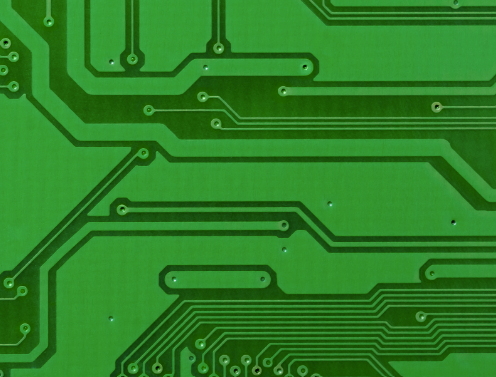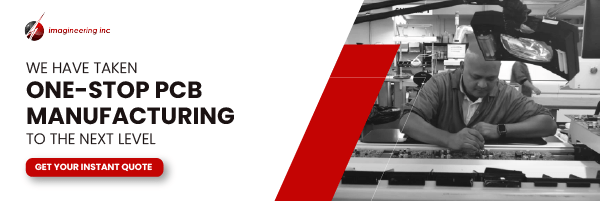What is the best PCB substrate for your next printed circuit board project? The substrate serves as the basis of a printed circuit board, and is often one of the first decisions that is made in the PCB design process.
Not only does the PCB substrate serve as the lattice for making connections that electrical signals can follow, but it also serves as the foundation for which component parts are bound to its surface. The two guiding principles around what material is used are functionality and price. Not surprisingly, the vast majority of consumer electronics use the same PCB substrate thanks to its efficiency and low cost.
In this blog, we answer what a PCB substrate is, how it is made, and the most common materials used to build the printed circuit boards that power our lives.
What is a PCB Substrate?
A PCB substrate is the material that holds the traces and components that make up the foundation of a printed circuit board. Selecting the right substrate material is crucial for the outcome and success of a high-quality PCB project.
PCB substrates are created in a way that has often been compared to a sandwich. Generally, the layers are indicated as follows:
- At the center is the core, a rigid base material that serves as the printed circuit board’s primary insulating material which is usually covered in copper foil as an internal ground plane.
- Coating the core is prepreg, a dielectric material binding agent that covers the core.
- An outer layer of foil is attached to the surface, forming the surface area which component parts will be attached and traces will be etched.
- Finally, the solder mask is applied on the surface, which is used primarily to protect the copper traced from oxidation, prevent solder bridges, and assist in visual inspections of the board.
- Silkscreen is added to indicate what parts lie where on a board, and while they are considered a layer of their own, it provides no material benefit.
When we are referring to the PCB substrate, we are generally referring to the prepreg and core material. Substrates offer a variety of options that are designed to suit the purpose of the end-user.
How are PCB Substrates Made?
As mentioned above, PCB substrates are organized by layers during their manufacturing. These can be as simple as one-sided PCBs or stacked in multi-layer PCB configurations. These layers alternate between dielectric material and metal foil.
The majority of PCB substrate materials are mixed with an epoxy, thanks to excellent electrical performance that come from lower dielectric constants and loss tangents compared to other materials. The chemistry of resins has evolved over time to address the higher temperatures of lead-free soldering, which has become important in the industry due to environmental concerns about lead-based printed circuit boards.
As we look into the kinds of substrate materials used in manufacturing printed circuit boards, it is important to remember that as performance improves, so does the cost. The kind of printed circuit boards required for telecommunications, military hardware, and aerospace engineering need to perform at much better rates than a telephone that might be discarded within a few years. Thus, when looking at the list, consider the end-use first before prioritizing optimal performance.
Types of PCB Substrates
FR-4
FR-4 printed circuit boards make up the vast majority of printed circuit boards available on the market. This is by design: made out of a woven glass reinforced by epoxy resin, FR-4 boards are low cost, perform well, are lightweight, and have good moisture resistance.
To clarify: FR-4 is not a material, but a classification that indicates its flame resistance
While FR-4 is great for consumer electronics, it has a high dielectric loss, making it unsuitable for high-speed or high-frequency applications. When price is the most important factors, printed circuit board designers turn to FR-4 to deliver great results at minimal cost.
Flex PCB Substrates
Wearable technology is one of the biggest developments in consumer electronics. Combining the functionality and utility of smart devices with the convenience of fitting around a wrist, it shows just how we have come over a decade, and how far we have yet to go. These devices would be impossible without flexible printed circuit boards.
Flexible printed circuit boards have a variety of applications that go beyond what we wear. Thanks to the fact that these printed circuit boards can bend, flex PCBs can fit a ton of surface area into limited or unusually shaped spaces. This makes them used from everything from calculators and video game systems to medical devices and satellites. They can even function in areas with environmental hazards.
The biggest feature of flex PCB substrates is their ability to bend. Thus, their material composition is soft, and are formed with an epoxy that is generally shaped around a glass weave. Some common substrates include:
Polytetrafluoroethylene – Commonly known by its brand name, Teflon, PTFE is the go-to option for flex PCB materials. With good temperature stability and low dissipation, they are found in cruise control, power amplifiers, antennas, and aerospace telemetry.
Polyimide – Polyimide has a good temperature range, high chemical resistance, and solid conductive properties. This material makes a good option for small consumer goods like gaming devices, cameras, and calculators.
Polyether Ether Ketone – For the most extreme conditions, PEEK can’t be beat. It can handle high amounts of radiation, great chemical resistance, and a high melting point. The properties of this printed circuit board substate make it used in medical technology like X-rays and gamma ray machines, as well as on aircraft.
Rigid PCB Substrates
Unlike flexible printed circuit boards, rigid circuit boards are immobile. This makes them less shockproof, waterproof, and resistant to corrosion. Yet despite these setbacks, rigid PCBS are durable, cost-effective, and powerful.
Rigid printed circuit boards are generally ceramic-based substrates. These boards have high thermal conductivity and high operating temperature. They are compact, meaning that they can take up less space than some of their counterparts, and are the easiest types of boards to repair.
Three of the most popular ceramic-based printed circuit board materials are:
Aluminum – With strong thermal dielectric and low expansion, aluminum is the most popular type of ceramic printed circuit board. Able to operate up to 350˚C before reaching its melting point, it boasts excellent high-frequency performance in even the harshest high-temperature applications. However, the thermal conductivity of these printed circuit boards does not meet the demands of high-power devices like integrated circuits. It is generally used in cooling and heating, LEDs, medical circuits, and sensors.
Aluminum Nitride – High-power devices like LEDS, integrated circuits, and sensors rely of aluminum nitride substrates in their printed circuit boards. Aluminum nitride substrates have thermal conductivity that is nearly ten times higher than aluminum printed circuit boards.
Beryllium Oxide – This substrate material boasts an even higher thermal conductivity than aluminum nitride, making its potential applications even more advanced. One problem, however, is that it is extremely toxic during the machining process. It is used in industrial microwave ovens and high voltage integrated circuits.
Additional materials, such as silicon carbide, are also available for the most advanced applications such as laser fields, with strength at up to 1400°C. Yet with a material composition identical to diamond, it remains well out of the price range of most consumers.
Flex-Rigid PCB Substrates
Why not have the best of both worlds? Flex-rigid printed circuit boards combine both types of materials and are generally used in aerospace, medical, and military applications.
They rely primarily on polytetrafluoroethylene components such as RO3000 and RO4000 thanks to both being simple to create and having low dielectric loss at microwave frequencies.
Not Sure What Material to Use? Contact the Experts
Making decisions around printed circuit boards can be challenging, and requires professional expertise. Come to Imagineering to get the best-in-class fabrication and assembly of printed circuit boards. Contact us today for more information about our services, or request a quote here.


